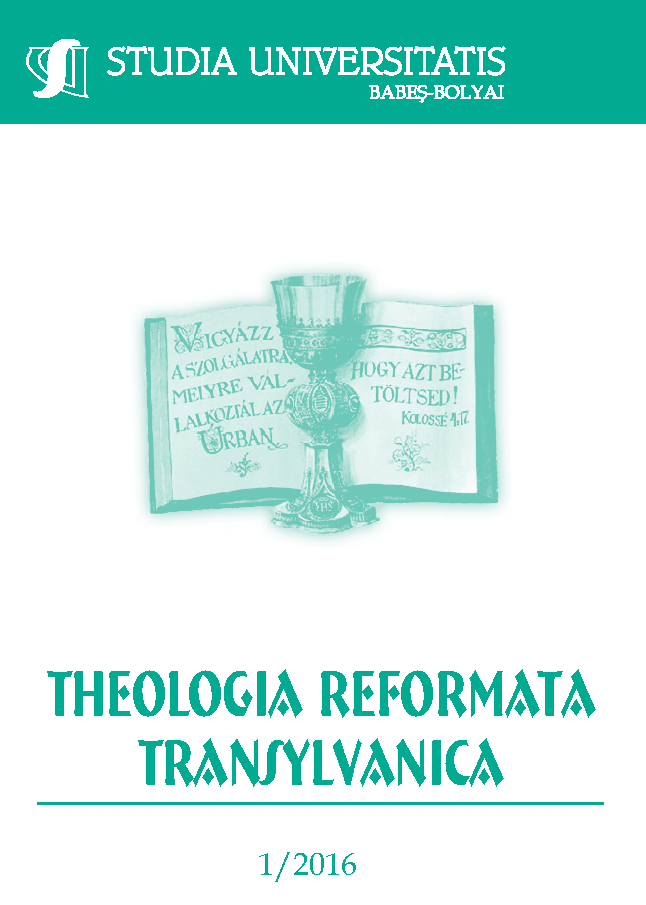Unterricht in der hebräischen Sprache in Siebenbürgen im 17. Jahrhundert: Das Collegium Academicum und János Apáczai Csere
Keywords:
Reformation, school, education, academy, teaching staff, analytic program, Hebrew language teaching, Hebrew grammar, university foundationAbstract
Hebrew Language Education in Transylvania in the 17th Century: János Apáczai Csere and the Collegium Academicum
In the introduction, the study presents the educational situation formed under the effect of the Reformation period, the location and proportion of schools founded in the second part of the 16th century and in the 17th century. Next comes the description of a higher intellectual level necessity, which in times of independent Transylvanian principality, under the domination of Gábor Bethlen led to the foundation of a higher education, respectively named Collegium Academicum. The study relates about the economic and intellectual procedures and steps to follow in the foundation of the institution, closer about the teaching staff. This was the moment of Martin Opitz, Iohannes Alsted, Philippus Piscator and Johannes Bisterfeld’s arrival to Transylvania. Due to these teachers from abroad, the school in Gyulafehérvár becomes a well-known and attended one. As it aims for the reader to know about the history of teaching Hebrew language in Transylvania, the study details the structure of some of the taught disciplines, among which that of the Hebrew grammar written in Latin by Alsted in 1635, too: Rudimenta Hebraicae et Chaldicae. Following the grammar presentation, the study offers an analysis of Alsted’s pedagogical methods, aim and know-how of teaching foreign languages. In the history of Transylvanian schools, János Apáczai Csere takes over and continues the application of the Hebrew language teaching pedagogy, developing it at university level. The study relates about Apáczai’s life and scientific carrier. The detailed analysis of the inaugural speech from Gyulafehérvár, De Studio Sapientiae, of the manual entitled Magyar logikácska published in 1654, of the manual entitled Magyar Enczyklopedia, of the inaugural speech from Cluj in 1656, of the publication named De summa scholarum necessitate have as pedagogic aim the presentation and description of the importance of the Hebrew language at university level, according to Apáczai. His pedagogy and teaching politics would constitute the base for the University founded in the second part of the 19th century in Kolozsvár.
References
APACZAI Csere János,: Magyar Enciklopédia. Sajtó alá rendezte, a bevezető ta-nulmányt és a magyarázó jegyzeteket írta Szigeti József, Bukarest, 1977
APACZAI, Csere János: De studio sapientiae.
BAN, Imre: Apáczai Csere János. Budapest, 2003
BUZOGANY, Dezső: Harc a tiszta evangéliumért. Kolozsvár, 2006
JAKAB, Béla: Opitz Márton a gyulafehérvári Bethlen iskolánál. Pécs, 1909
KOMOR, Ilona: Opitz Márton gyulafehérvári tanársága. Fil. Közl. 1955
KÖPECZI, Béla és Gábor BARTA: Erdély rövid története. Hrg, Akadémiai Kiadó, Bu-dapest, 1989
LUKACS, Olga: Bevezetés az erdélyi református iskolatörténetbe. Egyetemi Műhely Kiadó, Bolyai Társaság. Kolozsvár, 2008
LUKACS, Olga: Bevezetés az erdélyi református iskolatörténetbe. Kolozsvár, 2008
LUKACS, Olga: Johann Heinrich Alstedius “Diatribe de mille annis apocalyptcis” c. művé-nek angliai hatása. In: Studia Universitatis Babes-Bolyai, Theologia Re-formata Transylvanica, Kolozsvár, 2002
LUKACS, Olga: Magic Features in Johann Heinrich Alsted’s Apocalyptics. In: The Role of Magic in the Past. Pro Historia, Editor: Blanka Szeghyova, 80 969366-3-8, BDI, 2005
MÉSZÁROS, István: Oskolák és Iskolák. Tankönyvkiadó, Budapest, 1988
NAGY, Géza: Geleji Katona István személyisége. Kolozsvár, 1940
TONK, Sándor: Erdélyiek egyetemjárása a korai újkorban, 1521–1700. Szeged, 1992
TÖRÖK, István: A kolozsvári Ev.Ref.Collegium Története. Kolozsvár, 1905
VÁRÓ, Ferencz: Bethlen Gábor Kollégiuma. Nagyenyed, 1903. 39
Downloads
Published
How to Cite
Issue
Section
License
Copyright (c) 2016 Studia Universitatis Babeș-Bolyai Theologia Reformata Transylvanica

This work is licensed under a Creative Commons Attribution-NonCommercial-NoDerivatives 4.0 International License.






